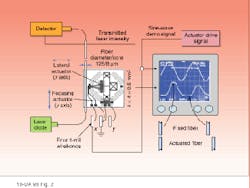In-package microaligner speeds fiberoptic packaging
JOHN M. HAAKE
The packaging of individual single-mode optoelectronic components currently dominates product cost, representing 40%-50% of the total cost. High-volume, lower-cost optoelectronics manufacturing technologies must be developed to accelerate the full use of optoelectronic devices. In particular, the fiber-pigtailing process must be automated significantly to reduce the costs. Increasing the manufacturing throughput can be achieved with a faster single fiber-pigtailing machine or by many traditional pigtailing machines working in parallel—in either case, a significant capital investment.
This production bottleneck has slow ed deployment of single-mode optoelectronic devices for all-optical networks. These coherent systems require a backbone of critically aligned (less than 0.2 µm off alignment) single-mode, polarization-maintaining fibers to distribute the master oscillator signal to individual gallium arsenide-based amplifier devices. Until reliable, cost-effective single-mode fiberoptic alignment and bonding methods are developed, the commercial benefits of all-optical networks will not be realized.
A fully integrated, electronically controllable microelectromechanical fiberoptic aligner—small enough to fit into a standard optoelectronic hermetic package—offers the promise of faster throughput from a single machine (see Fig. 1). The in-package microaligner uses actuator technology to achieve both large forces and displacements. These forces are great enough to bend the fiber inside the package and overcome surface tension due to glue or solder, permitting the fiber to be aligned and affixed to an optoelectronic device
Manufacturing efficiencies
The prototype in-package microaligner, first developed by McDonnell Douglas Laser Systems Division (St. Louis, MO; now part of The Boeing Company; Seattle, WA), is a fully integrated electronically controllable three-axis micro robot. Its size (5 × 4 × 0.5 mm) allows one or more to fit into current optoelectronic packages.1
Attaching the alignment robot to the optical fiber literally moves the fiber-pigtailing robot from outside the package to inside the package. This device is the first to have all three orthogonal axes fully integrated together.2
The in-package microaligner devices are micromachined silicon chips that possess both mechanical and electronic functionality. Such devices are fabricated using silicon processing adapted from integrated-circuit manufacturing, for which a broad base of infrastructure and expertise exists.
For optoelectronic devices, a typical prealigned placement accuracy of fiber and components must be within 5–10 µm, easily achieved with current pick-and-place machines. Therefore, the actuators must deflect the single-mode optical fiber over this range. In addition, the force required to deflect by 40 µm a 125-µm-diameter fiber cantilevered by 2 mm inside a typical hermetic package is approximately 13 mN (see Fig. 2).The actuators were developed at the MCNC Technology Applications Center (Research Triangle Park, NC) and have a measured displacement greater than 30 µm at approximately 0.45 W of input power. The out-of-plane or z-actuator—a silicon/nickel bimorph—was qualitatively characterized to have a displacement of greater than 120 µm at 0.3 W.
At the same power levels, the available forces for the in-plane actuators were measured at more than 60 mN for some designs. Forces of more than 100 mN were predicted for the out-of-plane actuators. Therefore, for the typical cantilevered distances in a package, the in-package microaligner has several times more force and displacement than necessary to move a single-mode optical fiber.
The counterforce springs, which are in compression, are designed to bring the actuator back to the reference position, overcome the forces from friction and wirebond stiffness, and hold the actuator/fiber assembly in place during handling.
Cost—the final arbiter
The cost of the in-package microaligner is similar to the cost of an integrated circuit. The first prototypes were approximately $20 to $25 each, but there were only a few hundred devices amortized over prototype, nonrecurring costs. They were not optimized spatially, but the forces and deflections were shown to be several times larger than required.
The optimized actuator will be on the order of 1 mm2, meaning thousands of in-package microaligners can be fabricated on each wafer. With low recurring fabrication costs, these devices can easily achieve unit prices of a few cents per aligned fiber.
This microaligner potentially eliminates the need for expensive external automated fiber-pigtailing systems, which, in the high-volume manufacturing environment, is the choke point for fiberoptic alignment. Using a simple desktop computer and array of detectors, many alignments can be realized simultaneously. This alone will significantly reduce the cost of all single-mode fiber optically pigtailed components.
In addition to breaking a manufacturing bottleneck, the microaligner also allows researchers to test and characterize optoelectronic devices without the need for thousands of dollars worth of mechanical stages and piezo pushers. With a potential cost of only a few pennies per device, the in-package microaligner allows researchers to repeatably characterize thousands of devices simultaneously, thereby building a database of characteristics on optoelectronic devices. This capability currently does not exist.
The current automated external alignment systems are package- and device-specific. Like any tooling, they require different fixtures and tooling to hold packaging and to position and bond the coupled fiber. Because the in-package microaligner goes into the package, this tooling requirement also is eliminated.
ACKNOWLEDGMENTS
This work was performed under Army Research Office contract DAAH04-95-C-0007, funded by the Defense Advanced Research Projects Agency Defense Sciences Office. The author would like to thank MCNC Technology Applications Center and the Center for Advanced Microstructures and Devices, Louisiana State University (Baton Rouge, LA) for their significant contribution.
REFERENCES
1. D. K. Probst et al., IEEE Photonic Tech. Lett. 4(10), 1139 (1992).
2. J. M. Haake et al., "In-Package Active Fiber Optic Micro-Aligner," Proc. SPIE Vol. 3276-20 (Jan. 1997).

